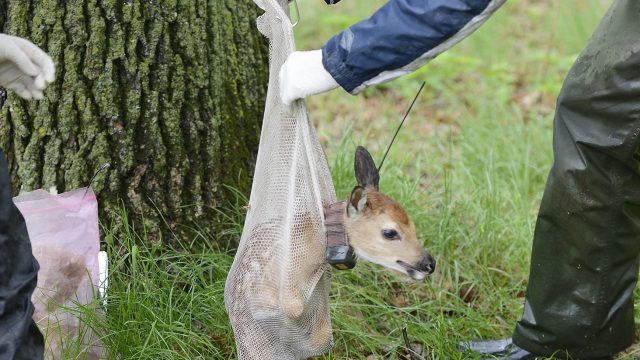Doug Leier: A Look At Wildlife Research By Game & Fish

My job as an outreach biologist is everything from working with local media and civic and school groups, to checking on possible fish kills, and even surveillance of moose or other critters in places we’d rather not have them.
I enjoy the variety and never pursued a career in natural resources with a goal of specialization, whether it was enforcement, fisheries, wildlife, disease or habitat. There are specialists, though, and many of them got there by doing post-graduate research on individual species.
In North Dakota, a fair amount of that type of research is funded by the State Game and Fish Department via grants to universities.
A recent story in North Dakota Outdoors magazine, published by the Game and Fish Department gives a brief snapshot of some of the research that is either ongoing, or has been recently completed.
Mule deer in western North Dakota
An ongoing five-year study in western North Dakota is investigating the influence of oil and gas development on mule deer populations. To get started, researchers fit 90 female deer with global positioning system radio tags to evaluate mule deer movements and survival, making it the largest project of its kind in North America.
Researchers will monitor mule deer survival through GPS tags and will receive email notification when a collar has not moved more than 50 meters in eight hours. Researchers then will attempt to determine the animal’s cause of death.
Wild turkey abundance in North Dakota
For this study, researchers use roadside brood count data, winter landowner and rural mail carrier surveys and other information to summarize relative abundance of wild
turkeys across North Dakota. With these estimates of abundance, Game and Fish
Department, biologists will be able to confidently manage populations across the
state with regulated spring and fall harvest, and maintain healthy, sustainable populations in the future.
During white-tailed deer research in the Wing area, 13 fawns were fitted with expandable radio-collars and monitored on a daily basis. Bed site analysis was conducted during the first 30 days of each fawn’s life. Of the 30 bed sites located, 70 percent were located with native grasses and Conservation Reserve Program.
Another white-tailed deer study with radio-collared does and fawns just got started last winter in southwestern North Dakota, and that followed a similar study in the northeast.
Ecology of mountain lions
The agency is funding research on mountain lions in the badlands in order to get a better handle on the lion population, so so we can manage harvest in a sustainable way.
The mountain lion field work in North Dakota started in August 2011. It involved capturing and putting collars on adult lions to track their movements and survival.
“If we get a better idea of adult survival, it makes our annual monitoring a lot more accurate,” said Stephanie Tucker, Game and Fish furbearer biologist she said. “We’ll better understand if our harvest is having an impact on the population and, if so, what kind of impact.”
Tucker said the study so far is giving biologists an unprecedented look into the lives of North Dakota mountain lions, including home range, habitat use, food sources and movement rates.
Sharp-tailed grouse in western North Dakota
Starting in 2010, researchers trapped and fitted more than 200 sharp-tailed grouse and their chicks with tracking devices in an effort to get a baseline idea of how grouse move and survive in relation the influences of landscape changes.
For a full accounting of the story, you can find North Dakota Outdoors magazine, Feb. 2013 issue, on the Game and fish website at gf.nd.gov.




